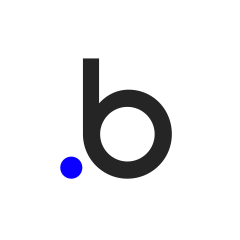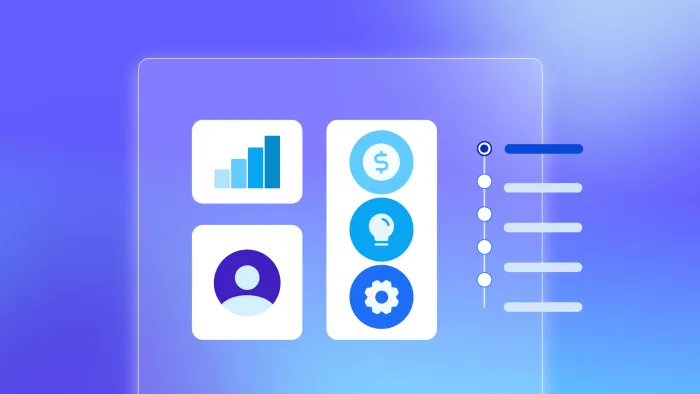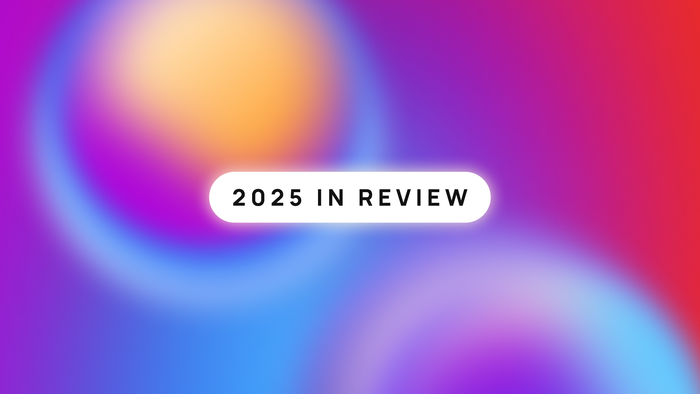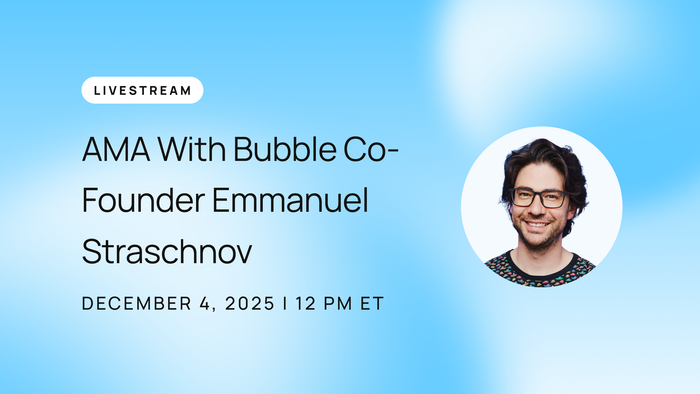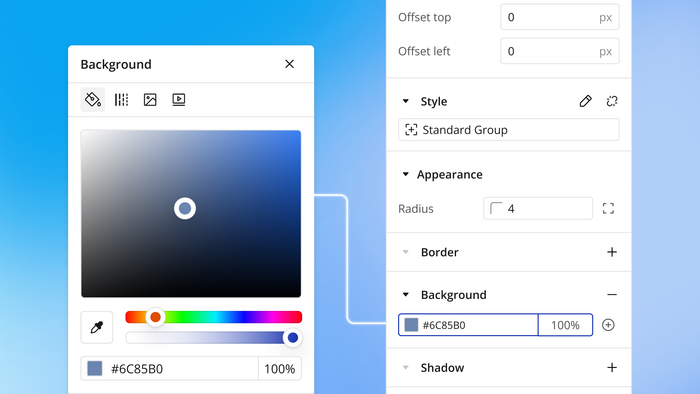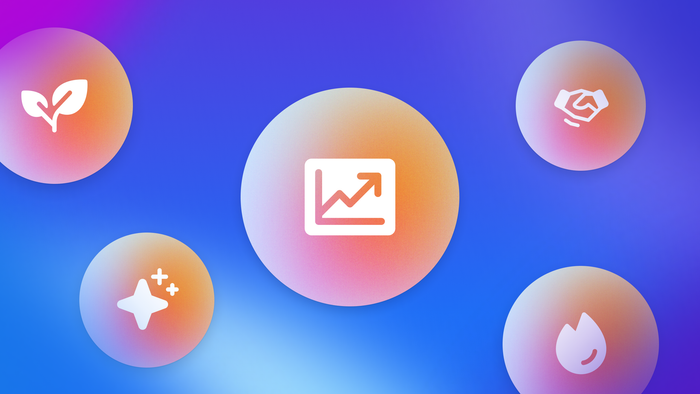Bubble makes it possible for anyone to build fully functional software without writing code. But chances are if you’re reading this, you aren’t just building an app — you’re building a business.
If you’ve created (or are creating) a business-focused software product and want to get it out into the world, B2B sales is your next step. Whether you’re a solo founder launching your first SaaS product or a team turning an internal tool into a commercial offering, this guide is for you.
We’ll walk through everything you need to know to sell your software to other businesses, from laying the groundwork to each stage of the B2B sales process. And we’ll share real case studies of successful B2B products built on Bubble to give you an idea of what’s possible.
What is B2B sales?
B2B (business-to-business) sales means selling your product or service to other businesses rather than individual consumers. For software, that usually means building tools that help companies work more efficiently, serve their customers better, or solve specific operational challenges.
It can also mean licensing your consumer product to a business that wants to provide it as a benefit to their users, like how some insurance companies provide a subscription to the Calm app to their members for free. Even though the app isn’t being directly used by the business, B2B sales led to that deal.
B2B software comes in many forms, from internal tools like CRMs or dashboards to customer-facing portals, white-label platforms, or industry-specific SaaS. But the common factor is that the customer is another business. That tends to mean longer sales cycles, bigger deals, and a buying process that revolves around measurable value and long-term fit.
B2B vs. B2C software sales
Both business to business (B2B) and business to consumer (B2C) sales involve communicating a product’s value. However, B2B is typically slower, more complex, and focused on long-term relationships.
For B2C, individuals decide on and purchase their software relatively quickly, based on factors like personal preference, design, convenience, or price. But for B2B, the deals often unfold over weeks or months. You’ll likely go through multiple conversations, demos, and approval steps — especially when selling to mid-size or enterprise clients.
Back to our example of insurance companies providing the Calm app to their members — were an individual consumer to get a meditation app, that purchase would be of little consequence. Just a few dollars and a click in the app store. Working out a deal between the app and the insurance company, on the other hand, is a far more complex process.
You’ll also be selling to a group, not just a single user. Although you may have a primary point of contact, that individual will be reporting to and gaining approval from operations leads, department heads, IT teams, legal, procurement, and other stakeholders. And all of them will have different priorities to navigate as part of the sales process.
You’ll have to prove that your app can solve a real business problem and continue doing so at scale. B2B customers are looking for reliability, ROI, and a partner they can trust.
Preparing to sell B2B software
Before you begin the B2B sales process, you’ll need to assemble the tools your sales team will rely on. That means crafting sales collateral: the content and resources that support the buying journey. This prep work saves your team from guesswork, ensuring they can provide accurate and helpful information at every stage of the process.
Define your pricing strategy
Pricing in B2B sales involves much more than a single sticker price. There are many different pricing models to consider, as well as the question of when and how to bring up pricing at all.
Start by choosing a pricing model that fits how your product delivers value to businesses. For B2B software, some of the most common models include:
- Tiered pricing: Offer multiple packages based on features, usage limits, and support level. Good for serving a range of customer sizes and needs.
- Per-seat pricing: Charge per user or team member. Common for collaboration tools and CRMs.
- Usage-based pricing: Bill based on activity, like API calls made, storage space used, or transactions completed. Ideal when usage varies widely between customers.
- Value-based pricing: Price according to the business impact you deliver, like time saved or revenue earned. Often used in high-ROI custom enterprise deals.
- Flat-rate pricing: One fixed price for all core features. Simple to manage, but offers limited flexibility.
- Hybrid models: Combine models for more tailored pricing. For example, tiered pricing that offers core packages plus usage-based pricing for individual overages.
Once you’ve picked a model, you’ll need to decide where to bring it up in your sales process. Bringing it up too early can scare off leads before they understand the value you’re offering. But waiting too long can backfire by eroding trust, wasting time with poorly qualified buyers, and creating unnecessary surprises during legal or procurement review.
Whatever you decide, be sure to equip your team with internal guidelines on introducing pricing, a pricing one-pager or calculator that outlines what’s included at each level, and clear discounting policies to avoid case-by-case exceptions.
You’ll also have to determine whether to publish pricing on your website. Transparent pricing can help build trust. But for high-value or complex solutions, it can often be better to introduce pricing during the sales conversation, giving you the chance to frame it in the context of the customer’s needs and expected ROI. And in some cases, it’s impossible to know how much the software will cost until you learn more about your potential customer’s needs — so it doesn’t make sense to share any pricing information until you’ve finished a discovery process anyway.
However you approach it, your pricing should always tie back to value. The numbers you quote should help the buyer justify an investment in solving a business problem.
Provide a centralized sales playbook
Sales reps — even if that’s just you for now — shouldn’t have to start from scratch every time they reach out to a prospect. A centralized playbook keeps messaging consistent and allows reps to stay focused on building trust and closing deals.
Your playbook should include key buyer personas, messaging guidelines, and “battlecards” — quick-reference guides for positioning your product against competitors, handling objections, and reinforcing your key differentiators in sales conversations. It should also outline where to engage your buyers (outbound email, LinkedIn outreach, events, partner channels, etc.), so reps know how to meet prospects where they are.
Additionally, the playbook can point sales reps to internal experts to loop in when a deal gets particularly complex, especially for legal, technical, or procurement questions.
Place your playbook in a secure, centralized location where it’s readily accessible to your team, like a Notion doc, shared drive, or CRM workspace. B2B sales can eat up a ton of time, so it’s worth setting up systems and doing things in a repeatable manner.
Organize objection-handling material
Questions, challenges, and qualms are bound to come up in the B2B sales cycle. When they do, your team needs to be ready to address them quickly, confidently, and consistently.
An objection-handling doc is a quick-access guide that provides authoritative responses to common concerns. It lists the most frequently raised objections, providing straightforward responses for each. That typically includes aspects like compliance, integrations, onboarding, and post-sale support. Where needed, the answers include links to additional resources like technical specs, case studies, or implementation guides.
It’s often worth creating two versions of the document. An internal version can provide extra context for your team, like positioning notes, persona-specific guidance, and tips on when to introduce certain responses. And an external version can be shared with prospects directly, presenting much of the same information in polished, buyer-friendly language.
Objection docs should be easily accessible, ideally kept in the same workspace as your playbook. And you should plan on keeping them updated with new responses as prospects raise new objections.
Build a standard pitch or demo deck
A well-crafted pitch or demo deck makes sure your sales reps are able to tell a clear, consistent story that resonates with buyers. It functions as a guided narrative that leads the buyer from pain point to solution, discussing the problem your app solves, how your approach is different, what results you can deliver, and what happens next.
To make the deck flexible, you can build it in modules. This lets your team swap in relevant industry examples, adjust proof points, or highlight specific integrations based on who they’re talking to.
You can also reuse parts of the deck in other assets, like your website, outbound emails, or social media posts. A strong pitch deck makes it easy to tell your story and adapt it to different contexts without starting from scratch.
Create your solutions sheet(s)
A solutions sheet quickly communicates what your product does, who it’s for, and why it matters. Think of it as a skimmable guide that sets the tone for your sales conversations. Solutions sheets may also be repurposed across outreach, pitch decks, and demos.
It should highlight your key value propositions, speaking to buyer outcomes rather than simply listing product features. And it may include social proof, like testimonials or recognizable logos.
The most effective solutions sheets are tailored to specific industries, roles, or use cases. For example, you might create different versions for heads of operations, IT buyers, and finance leads. Each one should be focused on the intended audience’s goals and pain points.
Prepare flexible case studies and proof points
Case studies and proof points build credibility by demonstrating how your product actually works for companies like the one you’re selling to.
A good case study highlights key metrics, a compelling quote, or a clear before-and-after result. It should be short, scannable, and ideally tailored to the specific industry, use case, or persona you’re targeting. Other kinds of proof points to prepare include ROI stats, industry benchmarks, and technical validation — the kind of information that can help prospects see value and build a business case.
They should be usable throughout the sales process. For example, a quick stat during outreach can spark interest: “We helped another fintech company reduce churn by 22%.” A technical example can help overcome objections mid-funnel: “Here’s how we integrated with their legacy system in two weeks.” And toward the end, decision-makers may want to see proven ROI: “After go-live, the team saw a 3x increase in lead response time.”
Balance public content with sales-led personalization
Before a buyer reaches out to sales, they often spend time on your website, reading a few blog posts and scanning your pricing and product pages. Your public-facing content may be the first impression a prospect gets, and it could determine whether they engage further at all.
At the same time, not everything belongs on your public site. Detailed pricing breakdowns or technical documentation can sometimes raise more questions than they answer or give away leverage in a deal. Some content is better shared selectively during the sales process.
Generally speaking, your high-level content should be easy to access. That includes solution overviews, blog posts, FAQs, light case studies, and simple comparison charts or calculators. These assets help prospects pre-qualify themselves before they reach out.
But you can save deeper or more tailored materials like technical docs or buyer-specific demos for conversations where you’re able to provide more context. This also gives your sales team space to add value, rather than simply repeating what’s already on the website.
The B2B software sales process: 7 steps
Once you’ve laid the groundwork and have your sales collateral in place, it’s time to start selling your software. The B2B sales process gives you a structured path for guiding prospects through the buying journey and closing deals.
1. Prospect new buyers
Prospecting is the process of identifying potential customers and starting a meaningful conversation.
Effective prospecting begins with a well-defined ideal customer profile (ICP). An ICP is a description of the types of buyers that are the best fit for your product. In the context of B2B sales, that means defining which companies are a match based on factors like industry, size, pain points, and likelihood to buy.
For example, if your app helps small accounting firms with onboarding, focus on firms with under 50 employees, and reach out to partners or operations leads. Or, if you’ve built a dashboard for enterprise procurement teams, look for department heads at large companies or public agencies. By staying focused on the companies that are most likely to buy, you avoid wasting time with prospects that would have never worked out.
In the early stages of prospecting, you can start with your warm network (friends, former colleagues, past clients) where conversations are more likely to lead to early traction. As you move into colder outreach, focus on personalized emails or LinkedIn messages that directly address the buyer’s role and pain points to increase your chances of getting a response. You can also participate in industry forums, Slack groups, or Reddit threads where your target customers spend time.
(And here’s a freebie: If your app is relevant to founders or developers, the Bubble Forum can also be a valuable channel!)
2. Discover customer needs
The discovery process is where you learn how a prospect’s business works, what problems they’re trying to solve, and whether your app is a genuinely good fit.
Ask open-ended questions and dig into their current process. What’s working and what isn’t? What’s taking too much time and effort? Try to understand not just the problem, but the broader context. Who else is involved? What does success look like for them? What roadblocks are standing in the way?
Discovery is also a chance to qualify the lead. A common framework used for this is BANT:
- Budget: Does the prospect have the necessary funds available?
- Authority: Are you talking to the decision maker or someone who can influence one?
- Need: Does your app address a clear pain point for the prospect?
- Timing: Are they ready to act on a realistic timeframe?
If the answer is “yes” to at least three of the four BANT criteria, a prospect is generally considered well-qualified. Keeping these factors in mind helps you prioritize leads and tailor your sales approach more effectively.
3. Schedule a demo
Once your discovery call confirms there’s a fit, the next step is booking a product demo. Best practice is to follow up within 24 hours.
Frame the invitation as a continuation of the conversation, not a sales pitch. Position it as a chance to show how your app addresses the specific pain points they shared.
Keep the message straightforward and personalized:
“Thanks again for the chat. Based on what you shared, I’d love to walk you through how [your app] can alleviate [pain point].”
Include a link to your calendar using a scheduling tool like Calendly or SavvyCal to streamline the booking process and avoid back-and-forth.
Before the demo, confirm who’ll be attending, and ask whether it would be helpful for any additional stakeholders to join.
4. Demo the product
The product demo is your chance to show how your app solves a real business problem. Focus specifically on the challenges the lead brought up during discovery. Now isn’t the time to go over all of your app’s features. Stick to what you know is most relevant to their needs.
Before the call, revisit your notes. What pain points did they highlight? Which workflows are slowing them down? What outcomes matter most to them? Use these insights to structure a personalized demo around their priorities.
Keep the tone conversational. A good demo should feel like a collaborative working session, not a one-sided presentation. Ask questions as you go, and check in to confirm that what you’re showing aligns with their process.
After the demo, follow up with a short recap that directly connects your solution to their goals.
5. Handle objections
Even after a strong demo, most buyers will have concerns, and that isn’t a bad thing. It means they’re seriously evaluating your app. Objections are openings for deeper conversation. Your job is to listen, clarify, and address those concerns.
This is where your objection-handling doc comes in. It gives you tested responses to common pushbacks, so you don’t have to reinvent the wheel every time.
If a new objection comes up that doesn’t have an obvious answer, loop in the right internal expert (as outlined in your playbook) for guidance. Once you’ve landed on a response that works, add it to the objection-handling doc so the whole team benefits next time it comes up.
As you address concerns, respond with curiosity, not defensiveness. Ask clarifying questions to understand the root of the hesitation. Share stories or proof points from similar customers. And maintain a collaborative tone. Your aim is to help the buyer solve a problem, not to win an argument.
6. Close the deal
The closing phase of the sales process is when you move a buyer from interest to commitment. By this point, they understand how your product solves their problem, they’ve worked through their objections, and they’re deciding whether to move forward. Your goal is to guide them through the final steps — answering any last-minute questions and helping them get to yes.
But in B2B sales, closing rarely ends with a simple “yes.” You’ll likely need to provide formal pricing, send over a contract, and loop in stakeholders from legal, finance, or IT. Ask what their internal process looks like and who needs to be involved. If internal discussions are still happening, confirm who the final decision-makers are and if your point of contact needs help bringing them around.
Once you have a verbal yes, follow up with a written summary and next steps. Outline exactly what happens after the signature, whether that’s onboarding, training, or a kickoff meeting. The smoother the path forward, the more likely the deal is to cross the finish line.
7. Onboard new clients
Your goal in onboarding is to help the customer experience your product’s value as quickly as possible. A strong start builds trust, reduces churn, and increases potential for expansion.
Start by clarifying what success looks like. What outcome are they hoping for in the first 30 to 60 days? Structure personalized onboarding steps around that goal.
Use a shared checklist or workspace to track progress and make responsibilities clear on both sides. This keeps momentum going and prevents onboarding from stalling out.
Anticipate common sticking points like setup steps, integrations, or internal approvals, and offer proactive guidance before they get in the way. Short video demonstrations, embedded templates, or annotated screenshots often work better than long documents.
Make sure the customer knows where to go for help and what kind of support you’ll provide. If you offer white-glove onboarding, define what that includes. If not, set expectations clearly.
Finally, don’t wait for signs of frustration. Check in early and often to address concerns, celebrate small wins, and spot opportunities to drive adoption across the team.
B2B success stories on Bubble
These case studies show what’s possible when you bring B2B ideas to life on Bubble, highlighting how Bubble apps are solving meaningful problems and generating real revenue.
BetterLegal
BetterLegal helps entrepreneurs handle the legal aspects of starting and running a business, from LLC formation to ongoing compliance. Instead of just offering templates, it delivers automated, ongoing services that small business owners rely on.
Founder Chad Sakonchick first built the platform using custom code and various SaaS tools, but development was costly and slow. After switching to Bubble, he was able to quickly rebuild the entire app with an optimized user flow. As a result, he doubled subscriptions almost immediately.
“A light bulb went off in my head: We can completely rip and replace everything we built, with Bubble,” Chad said.
BetterLegal is proof that you can build and grow a successful B2B SaaS business on Bubble. After the rebuild, they were able to reach $2.7 million in revenue and 15,000 customers as of 2023.
Mailead
Mailead is a cold email and CRM tool built for founders. It combines outreach, pipeline management, and inbox consolidation — all powered by Bubble.
When Jeremy Redman bought the app for $10,000, it had a few hundred users and no revenue. But in three months, he relaunched it and hit $400K in revenue, ultimately reaching a $2 million valuation.
“It is such an empowering feeling to take a sort of ‘template’ and build a real, meaningful business around it in Bubble,” Jeremy said. “I’ve proven to myself that I can do that and build something people want to buy.”
Maillead solves a core problem for early-stage sales teams: cold outreach tools are often too expensive. By offering drip campaigns, a unified inbox called the “Unbox,” and a built-in CRM at an accessible price.
Jeremy’s two-person development team rebuilt and relaunched the app in just six weeks. Maillead shows how quickly a lean team can turn a good idea into a revenue-generating B2B product on Bubble.
Build your B2B software on Bubble
Whether you’re launching your first SaaS product or scaling an enterprise tool, Bubble gives you the power to build fully functional software without writing a line of code. And with the sales process outlined in this article, you’ll be ready to turn your product into a thriving business.
From customizable interfaces to real-time testing and seamless updates, Bubble lets you build exactly what your users need and evolve your app as you grow — all on a secure, scalable platform. Get started for free.
Build for as long as you want on the Free plan. Only upgrade when you're ready to launch.
Join Bubble